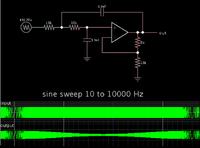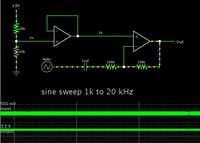Dinkleberg
Newbie level 2

Hi everyone,
For a project, I need to build a low-pass filter and connect it to the end of a high-pass filter and get a bandpass. The high-pass is already built and I am not allowed to do any changes on it. The bandpass I'll get must allow frequencies from 100Hz to 5kHz to pass. I simulated different combinations on lt spice but no luck so far. When I get the bandwith right, the amplification is wrong(about -50dB). I'd really appreciate any help on how I should build a low-pass there.
There's the built hpass. Uout is the output and the reference is M2. "Ub"s are supply voltage of the opamps. As you might guess MIC replaces a microphone that can produce max ac 0.5V. Unfortunately I didn't get any screenshots of my nearly succesful low-passes. They were damping every signal anyway...

For a project, I need to build a low-pass filter and connect it to the end of a high-pass filter and get a bandpass. The high-pass is already built and I am not allowed to do any changes on it. The bandpass I'll get must allow frequencies from 100Hz to 5kHz to pass. I simulated different combinations on lt spice but no luck so far. When I get the bandwith right, the amplification is wrong(about -50dB). I'd really appreciate any help on how I should build a low-pass there.
There's the built hpass. Uout is the output and the reference is M2. "Ub"s are supply voltage of the opamps. As you might guess MIC replaces a microphone that can produce max ac 0.5V. Unfortunately I didn't get any screenshots of my nearly succesful low-passes. They were damping every signal anyway...



